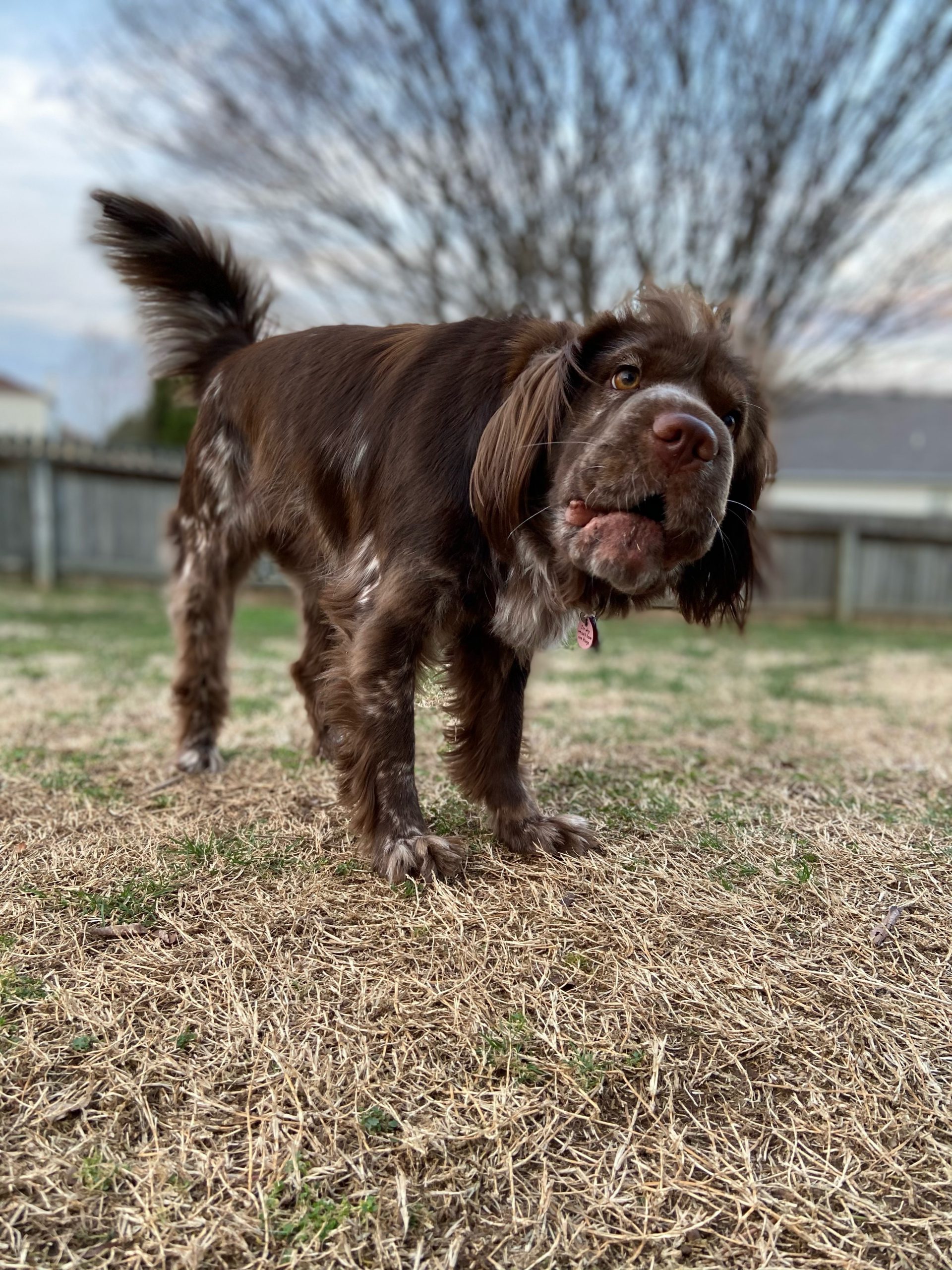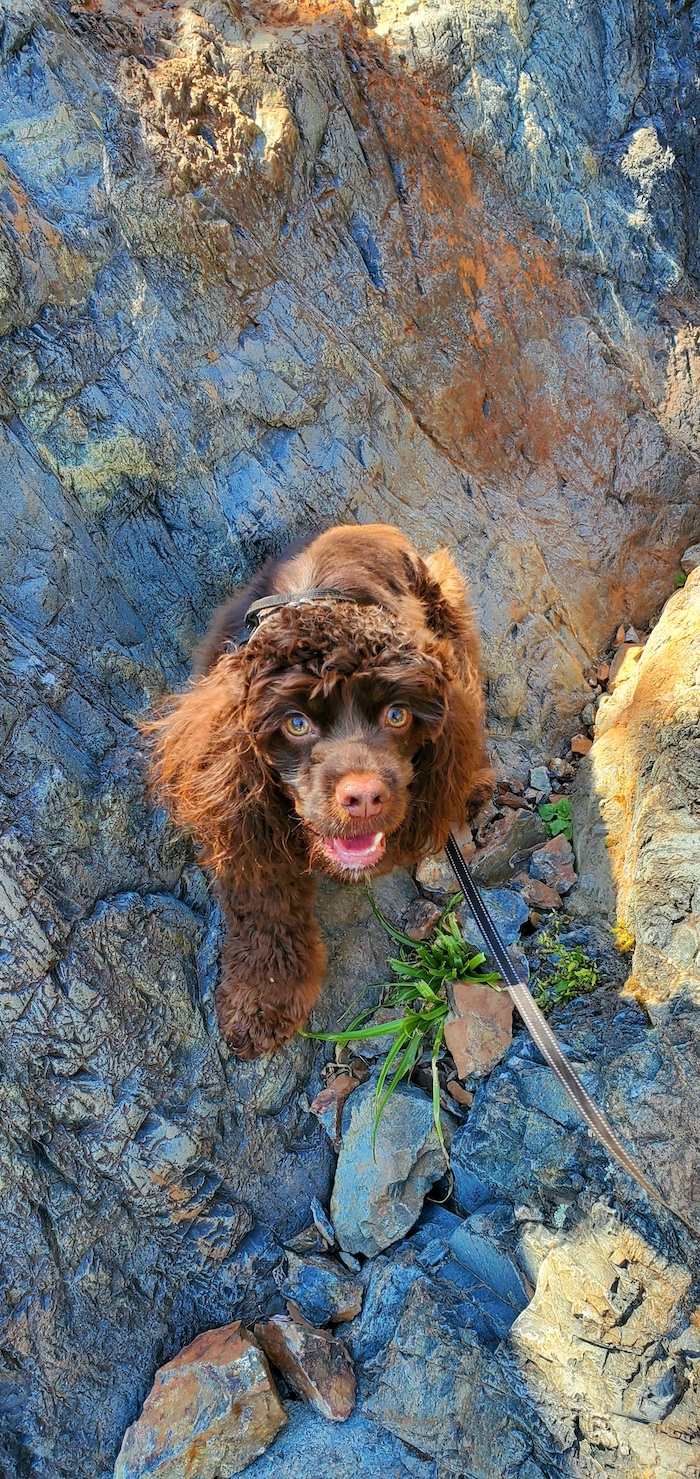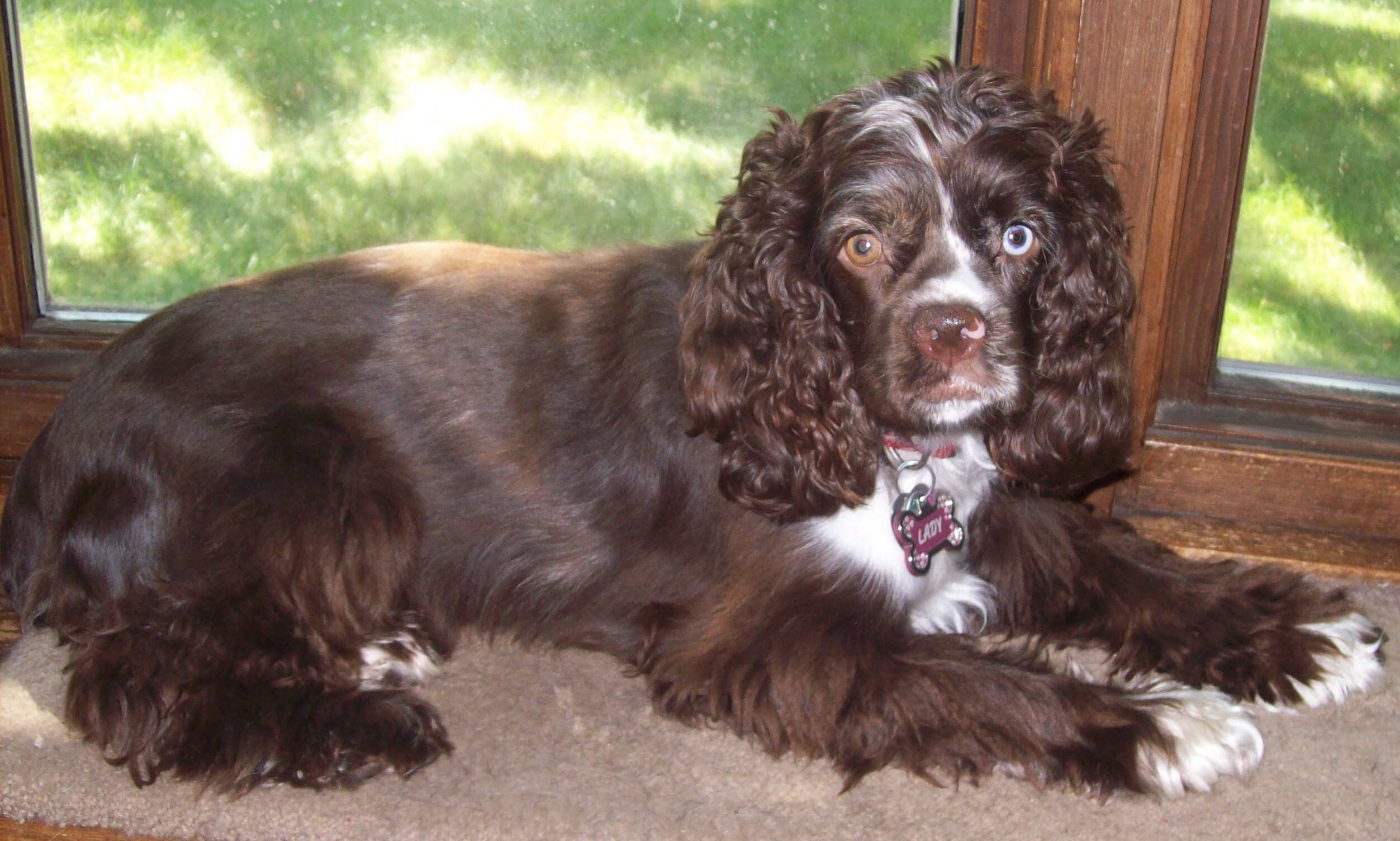Originally bred to hunt birds, cocker spaniels are energetic, athletic dogs that thrive on training and a job to do. But if you ask why they’ve spent decades as one of America’s most popular breeds, some experts will tell you it has more to do with their big eyes and floppy ears.
“It’s because they are so adorable,” says Gerry Foss of Cocker Spaniel Rescue of New England of the dogs’ perennial appeal. “They’re just so cute.” And, beneath the surface, cocker spaniels are often sweet, sensitive companions who enjoy play and snuggling. Of course, every dog is different, and breed is no guarantee of a particular personality.
For those considering bringing a cocker spaniel into their household, and those who already have one and want to understand the breed better, here’s the scoop.
Basic cocker spaniel facts
With a sturdy frame befitting their origins as hunters, cocker spaniels are categorized as sporting dogs. They stand about 13.5 to 15.5 inches high at the shoulder and weigh 20 to 30 pounds, making them the smallest sporting breed classified by the American Kennel Club. Their silky coats come in shades ranging from brown to red to black, and combinations thereof. Texture also varies, from straight to wavy.
Up top are big brown eyes hooded by expressive brows, set between long ears that extend (flop!) below the muzzle and slightly pouty jowls. The overall facial effect is indeed adorable—with a touch of “poor me,” says Lynne Turnquist of Rockstar Cocker Rescue in Illinois. “They do know how to work those eyes,” she warns.

Molly
Cocker spaniel personality
Windows to the soul, those eyes reveal a friendly personality. “Cockers love to be with people and are very social,” says Dorothy Lee, owner of Bailey. “Very friendly and lovable.” Above all, the modern cocker spaniel is a companion dog that needs to be around people. “You’ll never have another private moment in the bathroom,” Foss says.
“If he needs something, he will look deep in your eyes and gently tap you with his paw until you meet his request,” says Amy Palermo of her cocker spaniel mix Cosmo. “He lives for his green ball and will drop it at our feet when we come home or even when we are getting his dinner as a sign of pure joy.”
The downside of this temperament is anxiety in some cocker spaniels, especially when left alone. When placing cocker spaniels into new homes, “I like to look at who’s in the household and how often they’re home,” Turnquist says. “It’s hard to peg just one personality, but we kind of look at them as furry children.” This means that cocker spaniels can exude happiness, but may also pout or have what humans view as temper tantrums. The ideal cocker spaniel family is at home a lot, and will be attentive to the pooch. There are exceptions, but in general cocker spaniels are good with children and other dogs. “The majority of cocker spaniels are loving and snuggly,” Turnquist says. But, no matter what breed you’re dealing with, you should always supervise kids and dogs when they’re together and teach both parties proper respect and etiquette.
“At home” with his humans, Palermo says, her rescue Cosmo “is an absolute lover boy.” But he is uncomfortable in other social situations. “He doesn’t trust many people,” Palermo says, “which can turn his normally sweet temperament into fear and aggression. It makes it especially difficult when he has to go to the vet.”
Many cocker spaniels are down to hang regardless of the family’s plans. “Eevee is a very fun, energetic, loving, and intelligent girl,” says Samantha Salvador of her cocker spaniel. “She loves going to the dog park, especially when she sees her friends there. She also enjoys going on long walks and hikes.” As sporting dogs, cocker spaniels can be athletic and happy to get out and about. But—plot twist—back at home, cocker spaniels who’ve had enough exercise tend to chill out. “When you bring them in,” Foss says, “they settle.”
While the descriptions above capture several humans’ experiences with cocker spaniels, and reflect certain trends and tendencies among dogs of the breed, every dog is an individual. Whether you bring home a mix or a “purebred” cocker spaniel, there’s no guaranteeing what personality your pup will have, and you’ll need to be flexible with them and responsive to their preferences and interests.

Bailey
Cocker spaniel breed history
Technically, there are two breeds of cocker spaniel—the American and the English—but each one’s national designation disappears in their home country. The two breeds are very similar, though the American version is a bit smaller on average. All cocker spaniels trace their origins to Britain, where the dogs were initially bred by the 1800s to hunt a bird called the woodcock, which explains the “cocker” designation. “Spaniel” refers to Spain, where the ancestors of today’s spaniels originated centuries earlier. Once established in England, spaniels were bred to flush game from cover for hunters to shoot. Cocker spaniels had already gained a foothold in the United States by the late 1800s, and English breeders formally recognized the breed in 1892.
By the 1930s, Americans looking for companion dogs had caught on to the cocker spaniel’s charm and cuteness. The breed was America’s most popular from 1935 to 1953, after which it remained a top breed until it regained the top spot from 1983 to 1990, when the still-current Labrador retriever era began. In 2021, the cocker spaniel was the country’s 29th most popular breed. In Britain, it ranks third.
One reflection and propellant of the cocker spaniel’s 20th-century dominance was Disney’s 1955 animated film The Lady and the Tramp, a love story between two dogs: a mixed-breed male named Tramp and a doe-eyed cocker spaniel named Lady. One shared strand of spaghetti later, the cocker spaniel was a cultural phenomenon.

Molly
The breed is also a part of political history. As his party’s vice-presidential candidate in 1952, Richard Nixon weathered a major financial scandal by delivering on national television what historians later dubbed his “Checkers speech.” Checkers was the Nixons’ beloved cocker spaniel, a gift that the politician vowed he could never return. In 1964, The New York Times would cover the dog’s death. President John F. Kennedy had a cocker spaniel, too; Shannon was a gift from Irish president Éamon de Valera.
Fans of Oprah Winfrey may recall that among the mogul’s many canine companions have been cocker spaniels Sophie, Solomon, and Sadie. Winfrey has called Sophie, who died in 2008 at age 13, “one of my greatest teachers.” In a televised Masterclass, she said: “When I lost her is when I realized that nobody on earth had ever loved me like that little dog.”
Other famous folks who have owned cocker spaniels include George Clooney, who rescued Einstein in 2010. The actor told Esquire that he rubbed meatballs on his shoes to win the dog’s favor in the shelter. Clooney and his wife, Amal, later adopted a second cocker spaniel, Louis. Fellow jet-setter Elton John had a cocker spaniel named Arthur, who served as best man at the singer’s 2005 civil union to David Furnish. Other celebrity cocker spaniel owners have included Lauren Bacall, Ashley Judd, Elizabeth Taylor, Charlize Theron, Marilyn Monroe, Beatrix Potter, Naomi Watts, Prince William and Kate Middleton.

Eevee
Cocker spaniel training
Cocker spaniels are often affectionate and people-oriented, but they need training and socializing to get and stay that way. “People have to be willing to put in the time for training,” Turnquist says, “to work with them, to teach them some manners, to make sure they stay on course to be that wonderful dog.” True to their working-dog roots, cocker spaniels are quick studies who like to learn new skills. In his book The Intelligence of Dogs, Stanley Coren ranked them 20th for “working intelligence,” or how quickly and reliably dogs of a given breed learn and follow a new command on average.
Tricia Bentley reports success with training her 17-month-old cocker spaniel: “Phoebe is super smart and picks up training easily, which is typical for this breed.” It’s wise to start training early, and the process can begin when the dog first comes home. As emotional softies and people pleasers, cocker spaniels respond better to gentle, positive reinforcement. The dogs can be barkers, so curbing this impulse is an added incentive for training. But, having said that, understand that they’re going to bark from time to time—it’s one of the ways dogs communicate. What you’re trying to reduce is excessive, problem barking.
Viki Griner is very pleased with the impact classes have had on her cocker spaniel, Arthur. “Every groomer, vet, and even people at the UC Davis veterinary hospital always comment that Arthur is an absolute gentleman and has wonderful manners,” she says.

Cosmo, a cocker spaniel mix
Healthy lifestyle for cocker spaniels
Exercise
Exploit the cocker spaniel’s need to please when it comes to exercise. Walking is time spent together! Cocker spaniels are sporty, but hardly workout fanatics—so they needn’t run around to the point of exhaustion. Think moderate exercise. Many cocker spaniels like to scratch their hunting instinct by retrieving toys. They have a strong prey drive, so limit activities to enclosed yards or on a leash.
Megan McWilliams can attest to the breed’s instinct to chase because her seven-year-old rescue, Molly, whom she’s had since puppyhood, is quick to dart after a squirrel or rabbit. “Molly does not play fetch. She won’t bring the ball or stick back,” McWilliams says. “She prefers you chase her.” Lest anyone think Molly has lost her game-flushing heritage, know that she instinctively searches low bushes for rabbits.
Grooming and bathing
The cocker spaniel’s heralded good looks do not come easily. That flowing coat requires considerable, regular grooming. “Grooming is a necessity,” says Foss. “If they’re not groomed, they mat.” Left unchecked, matting can irritate skin on a breed already prone to dermatological issues. Watch especially for matting around the ears. “That was something we learned the hard way,” says Phoebe’s owner Bentley. “What we thought was a growth behind her ear was actually matted hair.”
Cocker spaniels also need regular shampoos with thorough rinsing to remove potentially irritating residue. Most owners comb at home and take their dog to a professional groomer on the regular. “Every eight weeks seems to be best for Fred,” says Fox. “You need to plan ahead to make sure the groomer is available, you’re available, and your dog is up to date on vaccinations. It’s a little more work than I anticipated.” It’s also a recurring expense to budget for.

Phoebe
Common cocker spaniel health concerns
Cocker spaniels in good health can live from 10 to 12 years. In addition to issues like arthritis, excess weight, fleas and ticks, and gum disease, which are common in many breeds, cocker spaniels are particularly susceptible to the following health concerns.
Ear problems: Having floppy ears presents challenges. By covering the ear canal, long ears foster a warm, humid environment where infections can take root. Matting of ear-area hair can exacerbate this situation. Prevent problems with regular grooming, while watching for changes and addressing early-stage issues. Over-cleaning a dog’s ears can itself cause problems or make them worse, though, so consult with a veterinarian about appropriate technique and frequency.
The glands in cocker spaniels’ ears can also overproduce wax, which can also lead to infections and other problems.
Often an underlying condition such as allergies or hypothyroidism needs addressing to prevent or defeat an infection—so keep the vet posted, especially if your dog shakes their head, scratches the ear area a lot, or expresses discomfort. Left untreated, ear infections can lead to chronic inflammation and damage to the ear canal and drum, hindering hearing. If they spread, infections can lead to even more serious consequences—so it’s best to see a veterinarian if you suspect one.
Eye problems: Eye concerns can affect dogs of any breed, but cocker spaniels’ trademark peepers are particularly susceptible to these four ocular problems.
Cataracts: As cataracts develop, the eye’s lens gradually becomes hazy, clouding vision and eventually leading to blindness. Many breeds are prone to cataracts in one eye, but some cocker spaniels can inherit a predisposition for cataracts in both eyes. Treatment options include surgery, which is often successful.
Cherry eye: The nictitating membrane—a third eyelid located inside of the visible lower eyelid—contains a tear-producing gland. When that gland prolapses, or slips from its usual position, it can become visible, red, and swollen in the corner of your pup’s eye. This condition is called cherry eye, and cocker spaniels are among the dogs most likely to face it. If you see signs of cherry eye, visit a vet as soon as you can. The condition is treatable, but often requires surgery.
Glaucoma: When dogs have this disease, high pressure in the eye damages the optic nerve and retina. This can lead to reduced vision and blindness. Glaucoma symptoms include eyeball protrusion, redness, pain, and light sensitivity.
Progressive retinal atrophy: An inherited condition with few treatment options, PRA is a degenerative disease that attacks cells of the retina, leading to reduced vision and blindness. Responsible breeders will screen for PRA.
Be alert for redness, excess tears, and changes to the lens, and call a vet if the dog paws at their eyes or seems to have trouble seeing.
Skin issues: Irritated itchy skin is the bane of many cocker spaniels and is often caused by environmental allergies, food sensitivities, or thyroid problems. “Being itchy is miserable,” Foss says. It’s not uncommon for skin-challenged cocker spaniels to also have related ear infections. A vet can try to identify and treat whatever has triggered the irritation. Sometimes figuring out the cause can be difficult. Be vigilant about grooming, hygiene, and skin treatments, as dermatological issues are an ongoing concern for many cocker spaniels.
Hip dysplasia: Hip dysplasia is a serious condition that can cause pain, hinder a dog’s mobility, and lead to arthritis. It occurs when the hip joint’s ball-and-socket connection doesn’t fit together smoothly. Tell your vet if your cocker spaniel is newly struggling to walk or climb, which could indicate that the hip is difficult to move or is hurting. Treatment options include pain medication, nutritional supplements to support joint health, and hip-replacement surgery.
Hypothyroidism: When a dog has hypothyroidism, the thyroid gland doesn’t produce and release enough hormone. Thyroid hormone regulates the body’s metabolism, so a cocker spaniel whose thyroid isn’t making enough may experience sluggishness, weight gain, hair loss, digestive issues, and other symptoms. Hypothyroidism is serious when undiagnosed. A vet will check your cocker spaniel for hypothyroidism by feeling the thyroid gland at the front of the neck, listening to their heart, and discussing any signs you may have noticed. Finally, blood tests will provide the definitive answer. The two most common causes of hypothyroidism in dogs are an autoimmune condition—in which the body attacks the gland—and idiopathic gland atrophy, “idiopathic” meaning basically that veterinarians are not sure why it happens. Very rarely, hypothyroidism can be caused by cancer.
There is no cure for hypothyroidism, but treatment options include hormone-replacement medicine and, if applicable, surgery to remove a tumor. With early treatment, cocker spaniels with hypothyroidism can expect a long, quality life.
Idiopathic epilepsy: Epilepsy is a brain disorder in which sudden electrical surges can cause seizures: tremors, shaking, or convulsions. “Idiopathic” epilepsy is epilepsy for which there is no apparent cause. A dog having a seizure might have trouble standing or chew excessively, and after the event—which will usually last for less than a minute—they may seem disoriented or sleepy. Before a seizure, dogs may hide or seek out their owners for comfort. During a seizure, they may collapse, become rigid, or flex and extend their joints. Unable to identify a cause, researchers suspect that idiopathic epilepsy is an inherited condition. The vet might prescribe anti-seizure medicine, which can be effective once the correct dose is established and administered regularly.

Eevee
Food and nutrition for cocker spaniels
All dogs need digestible, complete, and balanced food that supplies enough energy for daily activities and long-term good health—and cocker spaniels are no exception. Here is some food for thought.
Watch their weight: Extra weight puts additional stress on a dog’s heart, joints, and metabolism, so it’s important to control their portions and calorie intake while ensuring proper nutrition. Keeping your cocker spaniel in an ideal body condition can improve their chances of continued good health. A fresh-food plan makes it easy to feed the right amount of food for their age, size, and activity level.
Allergies and sensitivities: Alleviating or eliminating the triggers to a canine food sensitivity requires identifying the culprits, which can include certain proteins, artificial colors, and corn and soybeans. Your vet can help with this investigation. Finding a diet that is compatible with your pet’s allergies might mean undertaking an elimination diet. But it might also mean avoiding highly processed dog foods, which can contain unlisted allergens. Sometimes, dogs who have shown allergy symptoms associated with a certain protein can tolerate the ingredient when it’s prepared fresh rather than turned into extruded kibble.
Support heart and joint health: A fresh diet that provides balanced omega-3 fatty acids may promote cardiac health and help ward off joint issues. A pre-portioned fresh food plan also makes it easy to feed the right number of calories every day. This helps maintain a healthy weight, which is another key factor in keeping heart and joints healthy, as well as improving general health and quality of life.
Mind the teeth: Eating for dental health means eating for overall health—a fresh, whole-food diet promotes a healthier immune system, which helps ward off dental maladies. Crunchy kibble is often said to clean teeth, but it does no such thing. In fact, kibble is an ultra-processed food and as such can contain substances that actually fuel inflammation in the body, including in the tissues of the mouth. Most kibble is starchy and full of fillers that break down to sugar, which contributes to plaque and bacteria.
High-quality food for high-quality poops: A diet of fresh, lightly cooked food has been shown to be more digestible than processed kibble, and can promote a healthy gut and good digestion (which also means better, smaller poops).
A healthy diet—alongside training, exercise, vet care, and lots and lots of time together—is among the keys to helping your cocker spaniel live a happy life.

Lady
Where to get a cocker spaniel
If you have decided to welcome a cocker spaniel into your home, a great place to start is a rescue like Cocker Spaniel Rescue of New England, Oldies but Goodies Cocker Rescue, or Rockstar Cocker Rescue.
The post The Cocker Spaniel Breed Guide: Personality, History, Training, Food, and More appeared first on The Farmer's Dog.
Comments
Post a Comment